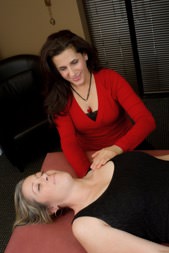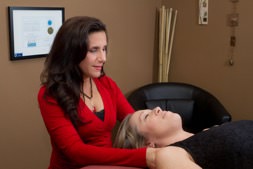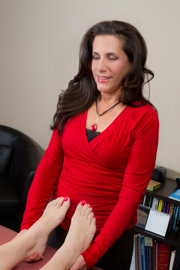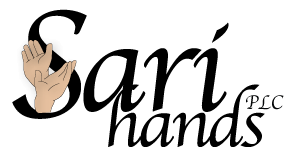Craniosacral Therapy

Craniosacral Therapy is a very gentle hands-on technique used to encourage calming of the nervous system. The craniosacral system includes the brain, spinal cord and surrounding tissues, all bathed in cerebrospinal fluid (CSF). Sari has studied and practiced Craniosacral Therapy techniques for 25+ years.
Newsletter about The Long Tide in Craniosacral Therapy
Craniosacral Therapy and Occupational Therapy:

After all, life really is better when you feel better!
The Craniosacral System:
The Craniosacral system includes the brain, spinal cord, surrounding tissues (the meninges) and the cerebrospinal fluid (CSF) produced in the brain and circulating throughout the system. This system is a semi-hydraulic pump, from the brain to and from the end of the spine. Variable rhythms of the CSF can be monitored and regulated, encouraging the body to heal, resulting in better overall wellness. Biodynamic techniques accommodate the internal movement of the body’s fluids related to the organizing and ordering movements within the embryonic development. In Biomechanical Craniosacral Therapy, the clinician uses techniques to follow movement of the bones and tissues. Both techniques are very gentle and calming to the nervous system. Sari is trained in both Biodynamic and Biomechanical Craniosacral Therapy.
A Safe Space for Healing:
Under stress, the capacity to connect the right and left hemispheres of the brain is diminished. The emotional right hemisphere cannot communicate with the more logical left hemisphere. Pre-verbal experiences can be difficult to integrate between the hemispheres. A trained therapist acts as the left hemisphere through verbal dialogue, sequencing and maintaining present time in the session. This way, the session is contained by the observation and tracking skills of the therapist.
Sari describes this phenomenon to her clients as 'Just dipping your toes into the edge of the pond, and not just plunging in.'
"Healing happens at the edge." – Franklyn Sills
Sari describes this phenomenon to her clients as 'Just dipping your toes into the edge of the pond, and not just plunging in.'
"Healing happens at the edge." – Franklyn Sills
Biodynamic Craniosacral Therapy:

Dr. Sutherland spoke about the Breath of Life as a divine communicating force that can help the therapist access the client's inner health. He perceived the Breath of Life as the palpable tidal movement of the fluids of the body. Its origin is in the book of Genesis in the Creation story and is also in the folklore of many cultures. Sutherland realized the importance of this work and his work shifted completely. He began to recognize the reverence and awe in the stillness and he devoted his study and research to this in his final years.
In Biodynamic Craniosacral Therapy, extensive study of neuroanatomy and embryology help to focus both the therapist and the client on their fluid bodies and a sense of stillness. Sari completed a 700 hour course in Biodynamic Craniosacral Therapy and became a Registered Craniosacral Therapist (RCST®) in 2003. Since then, she has completed 2 additional courses in Pediatric Craniosacral Therapy and acted as a teaching assistant for introductory and advanced courses in Biodynamic Craniosacral Therapy in the U.S. and Switzerland. Creating a safe environment for healing is a primary goal for Sari Lewis in her practice.
For more information, click here.

Biomechanical Craniosacral Therapy:
In 1970, John Upledger, D.O. observed an unexplained rhythm during a spinal surgery. When he attended a course in cranial osteopathy developed by William Sutherland, D.O. a few years later, he learned that the cranial bones continue to move throughout a person's life, and do not fuse, as was previously taught. He combined these two pieces of information to prove the concept of the semi-hydraulic Craniosacral system. Over the next decade, he researched and developed a system of light touch to evaluate and treat dysfunction in the brain and spinal cord, and developed The Upledger Institute in Florida in 1985. Dr. Upledger and his staff travel around the world to teach healthcare practitioners how to use these gentle techniques to enhance body functioning and help alleviate pain and discomfort. Sari completed four Craniosacral Therapy courses through the Upledger Institute.
http://www.upledger.com
Excerpt from the “CranioSacral Success Secrets” newsletter;
Dr. John once asked me to craft his personal vision into a declaration for his teaching institute and clinic. After looking back at the impact of his decades of work, this became the essence of his vision statement:
"People in every walk of life are learning, practicing and receiving CranioSacral Therapy and complimentary care that promote their natural gifts of self-healing."
http://www.upledger.com
Excerpt from the “CranioSacral Success Secrets” newsletter;
Dr. John once asked me to craft his personal vision into a declaration for his teaching institute and clinic. After looking back at the impact of his decades of work, this became the essence of his vision statement:
"People in every walk of life are learning, practicing and receiving CranioSacral Therapy and complimentary care that promote their natural gifts of self-healing."

"The global community is softening with compassion nurtured through genuine, caring touch."
I can still see Dr. John's face when I reflected his vision back to him for the first time. His eyes widened as he said, "That's it. That's why I do this work. It's all about empowerment and body-mind-spirit integration."
Sari blends Biodynamic and Biomechanical Craniosacral Therapy techniques (see definitions) in her practice, along with other gentle manual therapy techniques, creating an individual treatment plan for each client's needs.
© Sari Hands PLC
Sari Lewis • Phone 480–206-6592 • Email Sari
14362 N. Frank Lloyd Wright Blvd. • Suite 1000 • Scottsdale, AZ 85260
Sari Lewis • Phone 480–206-6592 • Email Sari
14362 N. Frank Lloyd Wright Blvd. • Suite 1000 • Scottsdale, AZ 85260
© web design by one eleven stockton, ca

